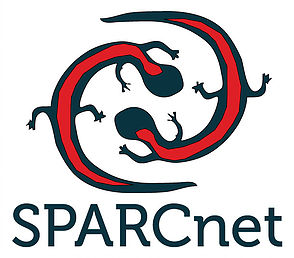Research and Teaching Opportunities with a Large-scale Salamander Collaboration Network (SPARCnet): TWS Poster
Author(s): Kristine Grayson1, M. Caitlin Fisher-Reid2, Louise Mead3, Hannah Coovert1, Raisa Hernández Pacheco4, Jennifer Sevin1, Alexa Warwick5, Tanya Matlaga6, Sean Sterrett7, Chris Sutherland8, Jill Fleming9, David Muñoz10, David Miller10, Evan Grant9
1. University of Richmond 2. Bridgewater State University 3. BEACON Center for the Study of Evolution in Action 4. California State University, Long Beach 5. Michigan State University 6. Susquehanna University 7. Monmouth Unversity 8. University of St Andrews 9. United States Geological Survey 10. Penn State University
1574 total view(s), 784 download(s)
SPARCnet_TWS_2020.pdf(PDF | 931 KB)
- License terms
Description
Abstract: Understanding wildlife responses to climate change has never been more urgent. For species with wide geographic ranges, there can be substantial variation in population processes and the effects from environmental change. Terrestrial salamanders in the genus Plethodon are often used in ecological studies as a key component of forest ecosystems, where lungless respiration through their skin and high abundance serves as a commonly used indicator of forest health. The eastern red-backed salamander (P. cinereus) is the most widespread and commonly studied species, yet most studies focus on local population dynamics. Understanding larger scale spatiotemporal patterns in population dynamics in relation to climate requires expanding beyond studies at single institutions. The Salamander Population and Adaptation Research Collaboration Network (SPARCnet) was founded in 2013 by researchers at Pennsylvania State University and the USGS Northeast Amphibian and Research Monitoring Initiative (NEARMI). It has since grown to include collaborators at 19 institutions and 8 education organizations. SPARCnet aims to provide a consistent framework for understanding population trends in P. cinereus, while delivering education opportunities for students. Researchers, educators, and citizen scientists apply the same cover-board plot study design and sampling methods across the range of the salamander in eastern and north-central North America. Most participants mark the salamanders they find, and thus have long-term spatial-capture-recapture data, along with basic population demographic data. Educators at these institutions are also developing course-based research modules available as open education resources for collaborative teaching. This network serves as an important model for bringing field research to students and building robust population data for species with wide geographic ranges.
Cite this work
Researchers should cite this work as follows:
- Grayson, K., Fisher-Reid, M. C., Mead, L., Coovert, H., Pacheco, R., Sevin, J., Warwick, A., Matlaga, T., Sterrett, S., Sutherland, C., Fleming, J., Muñoz, D., Miller, D., Grant, E. (2020). Research and Teaching Opportunities with a Large-scale Salamander Collaboration Network (SPARCnet): TWS Poster. SPARCnet: Educational Resources, QUBES Educational Resources. doi:10.25334/7CV0-TY57
